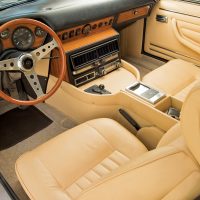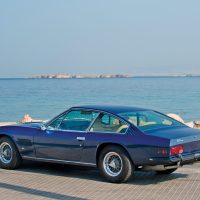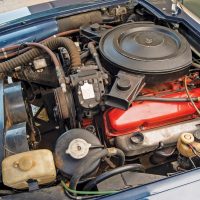SCM Analysis
Detailing
| Vehicle: | 1971 Monteverdi 375/L High Speed Coupe |
| Years Produced: | 1967–70 |
| Number Produced: | 50 (estimated) |
| Original List Price: | $24,500 |
| SCM Valuation: | Median to date, $33,750; high sale, $210,112 (this car) |
| Tune Up Cost: | $375 |
| Chassis Number Location: | Plate riveted on the inside left side of engine compartment |
| Engine Number Location: | Lower right side of block |
| Club Info: | Monteverdi Club |
| Website: | http://www.monteverdi.net |
| Alternatives: | 1970 Iso Rivolta GT, 1969 Bristol 410, 1971 Maserati Indy, 1970 Ferrari 365 GT 2+2, 1971 Jensen Interceptor |
| Investment Grade: | B |
This car, Lot 170, sold for $210,112 (£156,800, £1=$1.34), including buyer’s premium, at RM Sotheby’s auction in London, England, on September 7, 2016.
The theme of one of the episodes in the first season of “Jay Leno’s Garage” on CNBC Primetime was “No Replacement for Displacement,” the famous phrase attributed to W.O. Bentley when asked about the use of forced induction as a route to greater power. In my segment “Assess and Caress with Donald Osborne” on the show, among the three cars I chose was Jay’s 1971 Monteverdi 375/L High Speed. The choice was an easy one, given the hulking Chrysler V8 under the hood.
I have long been a great fan of international “hybrid” cars such as this, the Facel Vega, the Iso Rivolta GT, the Jensen Interceptor and the Bristol 407, 409 and 410. They all have in common a wonderful blend of subtle, sophisticated European style with smooth, effortless American power.
To be able to put your right foot down and feel yourself pushed back in a big, deep leather seat of an elegant, comfortable coupe — without the fear of delicate valves meeting pistons or camshaft lobes spinning themselves flat as you gather speed at a silly rate — is an experience quite unlike any other.
Italian style, American muscle
For those whose hearts beat faster when they see the distinctive and elegant lines of a car such as this — and who have no problem with mixed marriage — a Monteverdi 375 can be a fantastic choice. The combination of great design, a powerful and capable engine that is easy and inexpensive to maintain, a comfortable and roomy interior that encourages long drives, and the rarity is compelling.
Are there odd things about these cars? Certainly. The positioning of that big engine as far back as it is benefits the handling but leaves the air conditioning unit sitting between the driver and passenger in a very large box jutting out from the center of the dashboard. So what?
All cars such as this also tend to be the vision of a particular individual rather than a corporate product-planning group, so they certainly have no lack of character. That they were seldom built in the number for which the companies hoped was bad news when they were new — but this is great news today, when you’re unlikely to run into a car just like yours regardless of the event you may enter or even on a weekend drive.
A big, well-made tourer
One thing that surprises many when they first see a 375/L in person is how big a car it is. Like most successful designs, it’s difficult to tell how large or small it is from photographs without a scale reference. Regardless of its size, the driving experience is delightful. Monteverdi insisted that Fissore deliver cars built to a standard such that a Swiss businessman would have no need to apologize to his clients about his new, very expensive car. They succeeded admirably.
Very few of these cars ever became “beaters,” so that’s not an issue.
This particular example is a standout, as it came from the hands of the original owner, which is one of today’s most desired attributes of value. On another note, some worry about using cars such as this because of their rarity.
They usually share some trim components, such as taillights, with other builders. The taillights in this car come from an Alfa Romeo, and the windshield is from Maserati. The mechanicals are certainly no worry — and in any event, it certainly is worth the effort to keep one on the road, even if bumpers and body panels have to be fabricated.
It has long been my opinion that tracking values are useful as a reference rather than a goal for planning acquisitions. In all my communication about the collector car market, whether in the pages of SCM, in consultation with clients, in presentations at seminars and events or over a good meal with friends, I stick to a single belief: Motor vehicles can indeed turn out to provide a reasonable return on their purchase price over sufficient time, but they are almost always better bought for enjoyment.
A rare car on the rise
In my segment on “Jay Leno’s Garage,” I track the values of the subject cars over the past five years to give an idea of how the particular attributes of a vehicle have or haven’t resonated with the market during that time. Even though rarity is often a driver of value, Euro-American hybrids of this type haven’t enjoyed universal respect for very long. That’s all changing, as is clearly seen in the case of the Monteverdi.
In the period from April 2010 though May 2015, when the episode was shot, values of the Monteverdi 375/L had gone up 176%, with the last value at $188,000. Even with the Brexit-battered British pound trading at $1.34=£1.00 at the time of this sale, $210,000 was a very healthy number and pushed the increase to nearly 210% over the 2010 level.
Make no mistake — I still don’t think you should replace the long-term-growth mutual funds in your retirement account with Monteverdi 375/L High Speeds. But, if the car gives you the same thrill it gives me and Jay Leno, chances are you won’t go wrong.
This sale was absolutely market-right for this car, for this time and this moment. I hope the new owner is thrilled with his very special car and the seller is over the moon. There’s nothing quite like making a bit of money on a car you bought new, enjoyed, cared for and sold well 45 years later. ♦
(Introductory description courtesy of RM Sotheby’s.)


